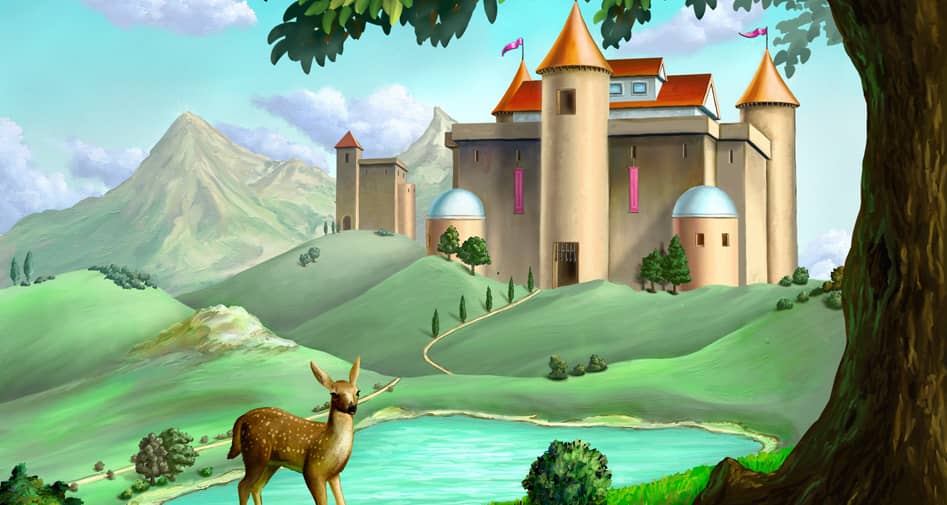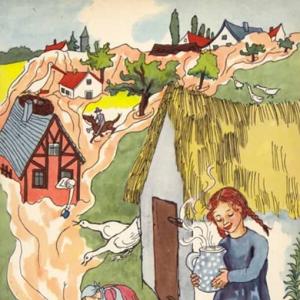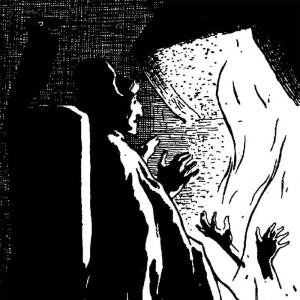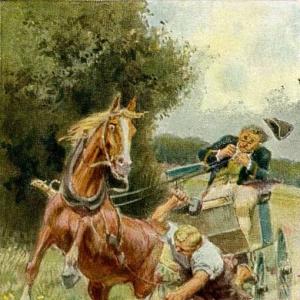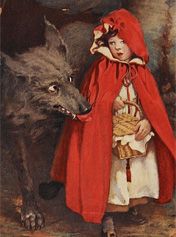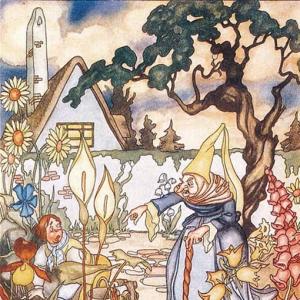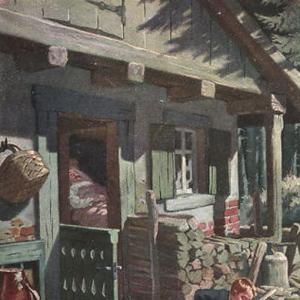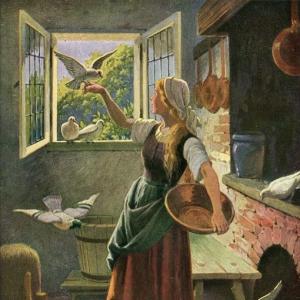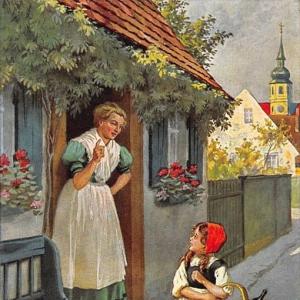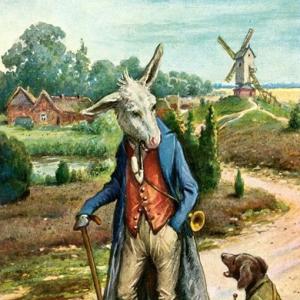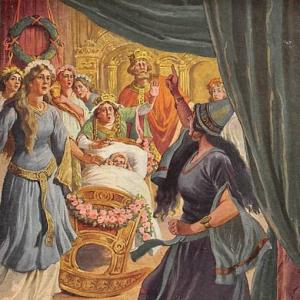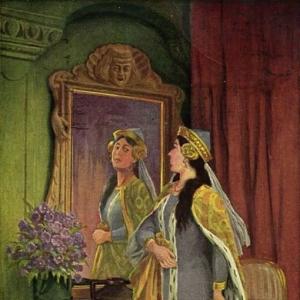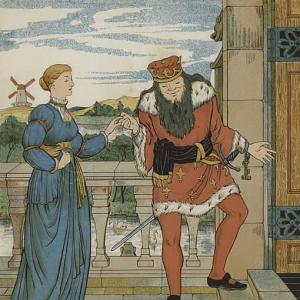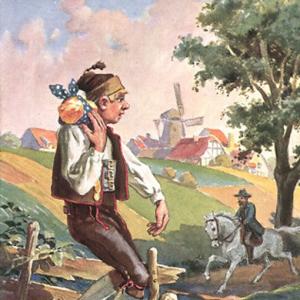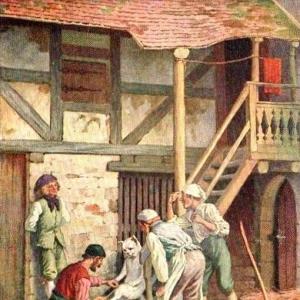Reading time for children: 3 min
There were once upon a time two sisters, one of whom had no children and was rich, and the other had five and was a widow, and so poor that she no longer had food enough to satisfy herself and her children. In her need, therefore, she went to her sister, and said, „My children and I are suffering the greatest hunger; thou art rich, give me a mouthful of bread.“ The very rich sister was as hard as a stone, and said, „I myself have nothing in the house,“ and drove away the poor creature with harsh words. After some time the husband of the rich sister came home, and was just going to cut himself a piece of bread, but when he made the first cut into the loaf, out flowed red blood. When the woman saw that she was terrified and told him what had occurred. He hurried away to help the widow and her children, but when he entered her room, he found her praying. She had her two youngest children in her arms, and the three eldest were lying dead. He offered her food, but she answered, „For earthly food have we no longer any desire. God has already satisfied the hunger of three of us, and he will hearken to our supplications likewise.“ Scarcely had she uttered these words than the two little ones drew their last breath, whereupon her heart broke, and she sank down dead.
 Learn languages. Double-tap on a word.Learn languages in context with Childstories.org and Deepl.com.
Learn languages. Double-tap on a word.Learn languages in context with Childstories.org and Deepl.com.Backgrounds to fairy tale „God’s Food“
„God’s Food“ is a lesser-known fairy tale collected by the Brothers Grimm in their compilation „Grimm’s Fairy Tales.“ Jacob and Wilhelm Grimm were German academics and linguists who collected and preserved traditional folklore and tales, first publishing their collection in 1812. The Brothers Grimm obtained stories from various sources, such as oral traditions, manuscripts, and printed materials, and their collection has had a significant impact on Western literature and popular culture.
„God’s Food“ is a moral and religious-themed story about two wandering brothers, one pious and the other wicked. The wicked brother, driven by envy and greed, abandons his pious brother in the forest. The pious brother prays to God, and an angel appears to guide him. When the pious brother becomes hungry, God provides him with food. Eventually, he encounters a king who is mourning the loss of his queen. The pious brother prays for the queen, who is then miraculously resurrected.
The tale emphasizes themes such as the consequences of good and evil actions, the power of faith and prayer, and divine intervention. Although the specific source of the tale is unknown, it is believed to have German origins, with the Brothers Grimm having collected it as part of their broader effort to preserve traditional folklore.
While „God’s Food“ has not gained the same level of popularity as other Grimm’s Fairy Tales, its moral lessons and religious themes have been retold and adapted in various forms, such as written works, audio recordings, and visual media.
Interpretations to fairy tale „God’s Food“
„God’s Food“ is a moral and religious-themed fairy tale that can be interpreted in various ways. Here are some possible interpretations of the story:
Consequences of Good and Evil Actions: The tale highlights the consequences of good and evil actions. The pious brother’s faith and devotion lead to divine intervention and blessings, while the wicked brother’s greed and envy ultimately bring about his downfall. This theme serves as a reminder that actions have consequences and that choosing a righteous path leads to rewards.
The Power of Faith and Prayer: The story emphasizes the power of faith and prayer. The pious brother’s unwavering belief in God and devotion to prayer result in miracles and divine intervention. This theme underscores the importance of maintaining faith even in the face of adversity.
Divine Intervention: The presence of an angel in the story symbolizes divine intervention and guidance. The angel leads the pious brother to safety and helps him overcome various obstacles. This element of the story reinforces the idea that those who are faithful and righteous will receive divine assistance.
The Importance of Humility and Compassion: The pious brother’s humility and compassion stand in stark contrast to the wicked brother’s greed and envy. This contrast serves as a reminder of the importance of cultivating virtues such as humility and compassion in order to lead a righteous life.
The Transformative Power of Faith: The story demonstrates how faith can transform lives and bring about positive change. The pious brother’s faith not only saves him from danger but also leads to the miraculous resurrection of the queen. This aspect of the story highlights the transformative power of faith and its potential to bring about miracles.
The Triumph of Good over Evil: The story ultimately conveys a message of hope, illustrating that good will triumph over evil. Despite the wicked brother’s attempts to harm the pious brother, the latter’s faith and devotion lead him to victory, emphasizing the power of righteousness and goodness.
While „God’s Food“ may not be as well-known as some other Grimm’s Fairy Tales, its moral lessons and religious themes offer a variety of interpretations and insights into the importance of faith, prayer, and leading a righteous life.
Adaptions of the fairy tale „God’s Food“
While „God’s Food“ is not as well-known as other Grimm’s Fairy Tales, it has still been adapted and retold in various forms. Here are some examples of adaptations of the story:
Books and Written Adaptations: The story has been included in numerous collections of fairy tales, often with adaptations to language, setting, or character names to make the story more accessible to contemporary readers. For example, „God’s Food“ may appear in a collection of religious-themed fairy tales or lesser-known Grimm’s Fairy Tales.
Audio Adaptations: „God’s Food“ could be adapted into an audiobook or podcast form, either as a standalone recording or as part of a collection of fairy tales. These adaptations may feature voice actors, sound effects, and music to bring the story to life and make it engaging for listeners.
Theater Productions: The story’s moral and religious themes lend themselves well to theatrical adaptations, such as stage plays or musicals. A local theater group might produce a play based on „God’s Food,“ emphasizing the story’s moral messages and religious symbolism.
Animation and Film: While there are no widely known film adaptations of „God’s Food“ specifically, the story’s moral and religious themes could make for an engaging animated short film or feature. Independent animators or filmmakers might create a film based on the story, focusing on the story’s unique elements and Christian symbolism.
Art and Illustration: The story’s vivid imagery and religious themes provide ample opportunities for creative visual storytelling through art and illustration. „God’s Food“ may have inspired illustrations in fairy tale collections, standalone artworks, or even graphic novel adaptations.
While „God’s Food“ may not have as many well-known adaptations as some other Grimm’s Fairy Tales, its moral lessons and religious themes offer a variety of opportunities for reinterpretation and retelling in different forms.
Adaptions of the fairy tale“God’s Food“
The fairy tale „God’s Food“ (also known as „God’s Gifts“ or „The Tablecloth, the Donkey, and the Stick“) has been adapted in various forms over the years. Here are some notable adaptations:
„The Magic Tablecloth“: This is an animated short film produced by Soyuzmultfilm in 1963. It is a faithful adaptation of the Grimm Brothers‘ tale, with the story told through beautiful animation and music.
„The Magic Table“: This is a children’s book written by Donna Jo Napoli and illustrated by Gabhor Utomo. It is a modern retelling of the Grimm Brothers‘ tale, set in a poor village in Indonesia. The story has been adapted to fit the culture and setting of Indonesia, but the themes of greed and gratitude remain the same.
„The Donkey and the Stick“: This is a play by William Butler Yeats, first performed in 1920. It is based on the Grimm Brothers‘ tale, but Yeats has adapted the story to fit his own poetic style. The play explores themes of power and corruption, and the consequences of abusing power.
„The Wishing Table“: This is an English-language version of the story, published in the 19th century. It is a retelling of the Grimm Brothers‘ tale, but with some changes to the plot and characters. For example, the tablecloth is replaced with a wishing table that can produce any food or drink, and the donkey is replaced with a magic purse that always contains gold coins.
„God’s Gifts“: This is a picture book adaptation of the Grimm Brothers‘ tale, written by Demi. The book features beautiful illustrations and simplifies the story for younger readers. The book emphasizes the importance of gratitude and humility, and the dangers of greed and arrogance.
Overall, the story of „God’s Food“ has inspired many adaptations over the years, each putting their own spin on the classic tale while preserving its timeless themes and lessons.
Summary of the plot
„God’s Food“ is a religious-themed fairy tale from the Brothers Grimm. The story follows two brothers, one pious and the other wicked. Driven by envy and greed, the wicked brother abandons the pious brother in the forest. The pious brother prays to God, and an angel appears to guide him. As he becomes hungry, God provides him with food, hence the title „God’s Food.“
The pious brother eventually encounters a king who is mourning the loss of his queen. The pious brother prays for the queen, and through a miracle, she is resurrected. The tale highlights the power of faith, the importance of prayer, and the consequences of good and evil actions. It emphasizes that those who are devoted to their faith and live righteously will receive divine intervention and blessings, while those who act wickedly will face the consequences of their actions.
As the story of „God’s Food“ continues, the wicked brother learns about the miraculous events that have taken place in the kingdom involving his pious brother. Overwhelmed with jealousy, the wicked brother returns to the forest in search of his brother, hoping to gain some of the blessings and divine favor that the pious brother has received.
Upon finding his brother, the wicked sibling tries to deceive him into thinking that he has repented and changed his ways. However, the pious brother sees through the deception and tells his wicked brother that true redemption can only be achieved through sincere repentance and devotion to God. The wicked brother, unable to genuinely change his ways, leaves in frustration, having failed to receive any blessings or divine favor.
The tale concludes with the pious brother continuing his life of devotion and prayer, while the wicked brother faces the consequences of his actions, serving as a reminder that the power of faith and the rewards of living a righteous life are only granted to those who are truly committed to their beliefs and values. Through its religious themes and moral lessons, „God’s Food“ highlights the importance of faith, prayer, and leading a virtuous life.
—————–
Backgrounds to fairy tale „God’s Food“
„God’s Food“ is a lesser-known fairy tale from the Brothers Grimm’s collection, which has been translated and adapted into various languages over the years. The Brothers Grimm, Jacob and Wilhelm, were German scholars, linguists, and cultural researchers who are best known for their collection of folktales and legends. They published their first volume of „Children’s and Household Tales“ in 1812, containing 86 stories. By the time the seventh edition was published in 1857, the collection had grown to include over 200 tales.
The Brothers Grimm aimed to preserve and document the oral tradition of German folklore, which they believed was an essential part of their national cultural heritage. Their work has had a significant impact on the study of folklore and the development of the fairy tale genre, inspiring countless writers, artists, and filmmakers worldwide.
„God’s Food“ reflects the darker side of the Grimm’s fairy tales, featuring themes such as hardship, suffering, and death. The story is set in an unspecified time and place, which is typical for many of their tales. The characters, like those in many other Grimm’s stories, can be seen as archetypes, representing various aspects of human nature and society. The rich sister embodies selfishness and greed, while the poor widow and her children represent humility, faith, and the harsh reality faced by many people living in poverty.
Like many other tales from the Brothers Grimm, „God’s Food“ has moral and ethical lessons embedded within its narrative, aiming to teach readers about the importance of compassion, empathy, and the consequences of our actions.
Interpretations to fairy tale „God’s Food“
„God’s Food“ is a cautionary tale that can be interpreted in several ways. Here are three main interpretations:
The consequences of selfishness and lack of compassion: The tale highlights the dangers of being self-centered and lacking empathy for others in need. The rich sister’s unwillingness to help her struggling family members leads to their tragic deaths. This story serves as a reminder that we should always be compassionate and charitable towards those who are less fortunate, as our actions can have far-reaching consequences.
The power of faith and the role of divine intervention: Despite their dire circumstances, the poor widow and her children maintain their faith in God, believing that He will provide for their needs. Their deaths can be seen as a form of divine intervention, as they are finally freed from their suffering and reunited with their deceased loved ones. This interpretation emphasizes the importance of maintaining one’s faith in times of adversity, and the belief that God will provide solace and relief in the end.
The concept of justice and retribution: The story also highlights the idea of justice and retribution for one’s actions. The rich sister’s refusal to help her family is punished when her husband discovers the bread filled with blood, a symbolic representation of her cold-heartedness and the suffering she has caused. In contrast, the poor widow and her children, who remained faithful and righteous in their suffering, are ultimately relieved of their pain and united in death. This interpretation emphasizes the idea that actions have consequences, and that justice will eventually be served.
Overall, „God’s Food“ is a powerful tale that teaches important lessons about compassion, empathy, faith, and the consequences of our actions.
Summary of the plot
„God’s Food“ is a grim fairy tale by Brothers Grimm about two sisters – one wealthy and childless, while the other a poor widow with five children. The poor widow and her children are starving, so she approaches her rich sister for help. However, her sister is cold-hearted and refuses to offer assistance, claiming that she has nothing to spare.
Later, when the rich sister’s husband returns home and tries to cut a loaf of bread, blood flows out of it. Horrified, the wife tells him about the widow’s visit, and he rushes to help the needy family. Upon entering their home, he finds the widow praying, with three of her children already dead and the remaining two clinging to life. He offers them food, but the widow states that they no longer need earthly sustenance, as God has already answered their prayers and satisfied the hunger of three of her children.
As she speaks, the remaining two children pass away, and the widow, unable to bear the pain, dies of a broken heart. The tragic tale demonstrates the consequences of selfishness and the importance of compassion and generosity towards those in need.
Informations for scientific analysis
Fairy tale statistics | Value |
|---|---|
| Number | KHM 205 |
| Aarne-Thompson-Uther-Index | ATU Typ 751G |
| Translations | DE, EN |
| Readability Index by Björnsson | 37.9 |
| Flesch-Reading-Ease Index | 74.2 |
| Flesch–Kincaid Grade-Level | 8.9 |
| Gunning Fog Index | 11.2 |
| Coleman–Liau Index | 8.3 |
| SMOG Index | 8.7 |
| Automated Readability Index | 10 |
| Character Count | 1.283 |
| Letter Count | 996 |
| Sentence Count | 10 |
| Word Count | 243 |
| Average Words per Sentence | 24,30 |
| Words with more than 6 letters | 33 |
| Percentage of long words | 13.6% |
| Number of Syllables | 310 |
| Average Syllables per Word | 1,28 |
| Words with three Syllables | 9 |
| Percentage Words with three Syllables | 3.7% |
